Assalamu alaykum
This page will discuss the Mihrab of the Prophet SalAllahu alayhi wasalam and the calligraphy found on it.
The Mihrab is truly a wonderful piece of art and engineering. What I used to find amazing about this piece of work, is that it was covered in beautiful calligraphy but I used to get angry and worried that I could not understand it. This was one of the main reasons I started my research as I found it extremely odd that such a beautiful piece of art is sitting in my Prophet’s masjid and I cannot fathom what it says.
Please see the image below:
This Structure is the Mehrab that is situated closest to the Holy Chamber. It is also right opposite the Mehrab where the present day Imam would lead prayers.
There are a number of important points to note. which we will cover InshAllah. Briefly the points are:
- This Structure is closest to the Holy Chamber – as opposed to another Mehrab that is to the right of this image.
- This Mehrab is situated adjacent to an important Pillar – The pillar of Mukhalaqa.
- The Structure has calligraphy that indicate that this is where our Holy Master SalAllahu alayhi wasalam performed his Holy Prayers.
A closer look at the Mehrab
The Cone
Starting with the cone on top of the Mehrab – circled in red. What do you think it says?
The calligraphy is from the Quran and describes an event that involved another Mehrab. The Quranic verse is the following:
Surah AL-Imran {The Family of Imran}, p/o Verse 37):
“Every time he (Zakaria) he entered Al-Mihrab (a praying place or a private room).”
The Upper Arch
Just above the Upper arch we find a small red plate that informs us of what this Mehrab is:
“This is the Mehrab of the Rasool Sal Allahu alayhi wasalam”
Right hand arch column
On the right hand arch column there is a sign that goes onto describe the actual place where our Holy Master actually prayed:
The sign reads:
“This is the place of prayer of the Messenger of Allah, Peace be upon him”.
The entire block has been placed over the place of prayer of our holy Master SalAllhu alayhi wasalam.
The left of the arch column
To the left of the arch column is written a hadith of our Holy Master SalAllhu alayhi wasalam:
The Prophet, Peace be upon him, said: “Prayer is the mainstay of religion”.
Right of the arch
The right of the actual arch itself starts off with the following Quranic Verse:
(from Surah #2 Al-Baqarah {The Cow}, Verse 144):
“Verily! We have seen the turning of your (Muhammad’s, Peace be upon him) face to a Qiblah (prayer direction) that shall please you, so turn your face in the direction of Al-Masjid Al-Haram (at Makkah). And wheresoever you people are, turn your faces (in prayer) in that direction.”
Over the arch continuing to the Left
This is another Quranic Verse:
Surah #33 Al-Ahzab {The Confederates}, Verse 56):
“Allah sends his Salat (Graces, Honours, Blessings, Mercy) on the Prophet (Muhammad, Peace be upon him), and also His angels (ask Allah to bless and forgive him). O you who believe! Send your Salat on (ask Allah to bless) him (Muhammad, Peace be upon him), and (you should) greet (salute) him with the Islamic way of greeting
As this is a command to send Peace and Blessings on the prophet, The next portion is the Durood:
The transliteration is:
“Allahuma Salli Alaa Sayyidina Muhammadin Khatimu Nabiyeen wa Mursileen wa Rasool ul Alimeen”
sometimes the photos that I took or the images I managed to attain had a lot of flash on them so it was difficult to actually elucidate what the Arabic calligraphy was saying. Using photographic software you can invert the colours to give you a clearer image. So, for the Durood Shareef I managed to attain the following image when the colours were inverted thus giving better view of the Arabic:
This ends the calligraphy around the arch. We will now continue to study the calligraphy within the Mihrab itself.
The text within the Mihrab itself
The text within the arch reads the following Quranic Ayat:
(These believers who have bargained with Allah for the Hereafter are those) who turn to Allah in repentance, worship, praise and glorify (Allah), fast, abstain from the worldly lusts, bow down before Him (most humbly and submissively) and prostrate themselves before Him (seeking His nearness), command good and forbid evil and guard the limits (set) by Allah. And give glad tidings to these believers.
(from: Surah #9 Al-Taubah {The Repentance}, Verse 112)
This is the end of the Description of the Holy Mehrab itself.
Behind The Mehrab
On the posterior wall of the mihrab is the historic inscription of five lines written in the Mamlooki Thuluth script:
1.”In the Name of Allah, Most Gracious, Most Merciful, and Peace be upon our leader Muhammad.
2.This Noble Mihrab has been placed in the prayer place of the Prophet by order of the Humble Slave (of Allah),
3.the Sovereign Ruler, Al-Ashraf,
4.Abu Al-Nasr Qaitibai. Allah is Eternal and Supreme.
5.In the month of Dhu Al-Hijjah (of the Sacred Months), in the year 888 A.H.”
Appended to the aforementioned inscription, in the same script, is the following:
6. Its renovation was ordered by His Majesty,
7.King Fahd bin ‘Abdul ‘Aziz AL Sa’ud,
8.Who Glorifies Allah, in the year 1404 A.H..

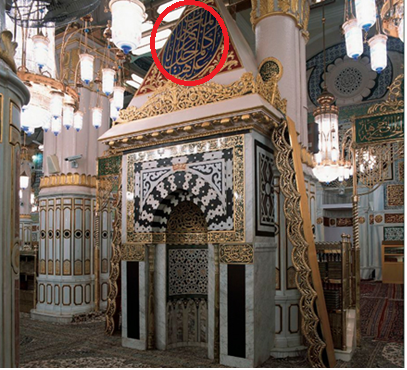

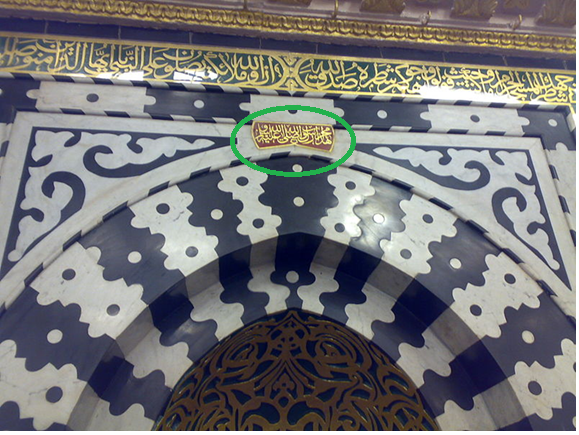
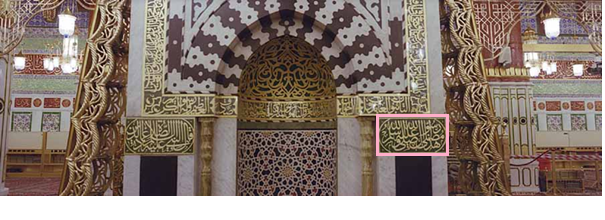
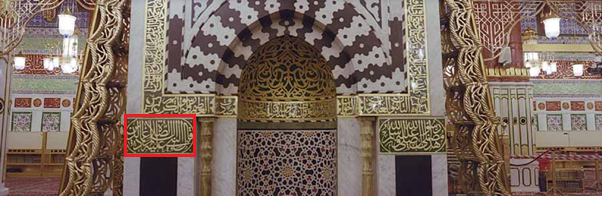
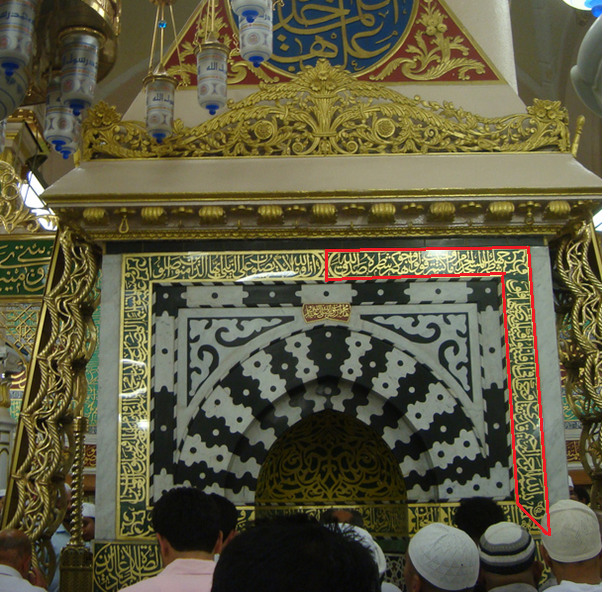

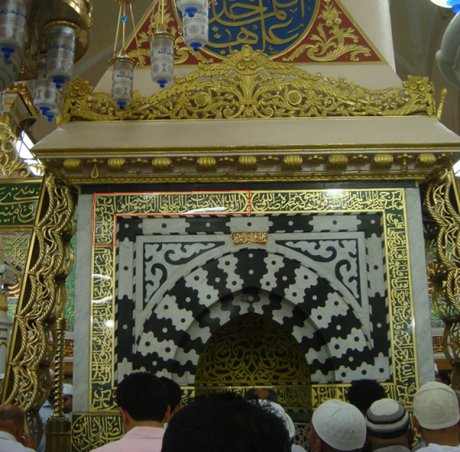

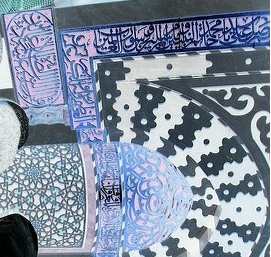
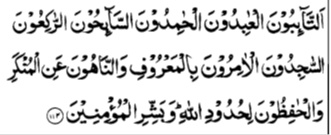
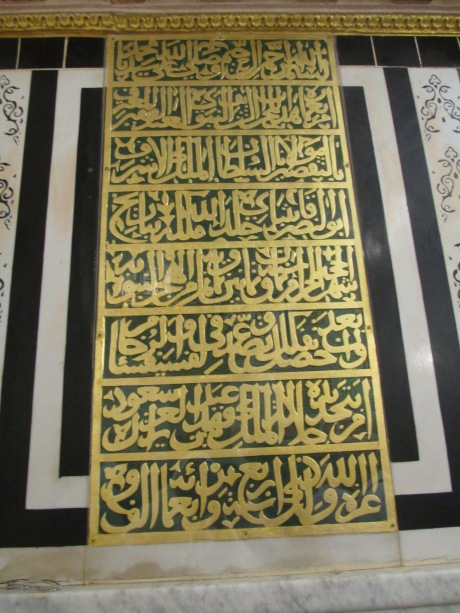
SubhanAllah, there are no words for this sacred place.
SubhanALLAH
Fantastic piece
Allahu Akbar.
[…] …translation of this panel on the Prophet SallAllahu alaihi wasallam Mihrab here… […]
This text is invaluable. Where can I find out more?
Salam
What would you like to find out about?
Sajid
MashaAllah a brilliant insight
JazaakAllah Khair
Subhanallah. i had just performed my umrah in ramadan 2014.
If i knew this then, i would have cherished my moment more
during my last ten days in masjid nabwi. again jazakallah for
For explainibg the caligraphy to me. this bookmark is unique
and valuable to me. May allah increase knowledge and make your quest for deen easy. aameen.
Salam
Please spread the word
Sajid
Mash-Allah…..great work.
I have a question: who decided the verses from quran…….The verses came later or it was already there from prophets time?
good job..you make easy work for me..becoz i m making a model of mahrab of masjid e nabi……thanks.give me other facts like that on my id plz nazamanwar@gmail.com
plz tell me the total length and width
of mehrab
Who selected the verses from quran? It was already from the prophet’s time?
Assalamu alaykum.
May Allah reward you for such a beautiful and informative website!
Ameen.